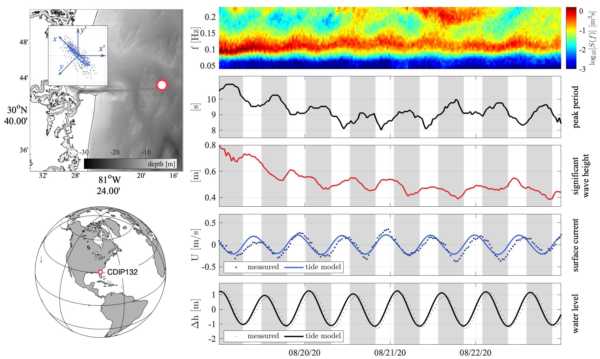Data from: Wave-tide interaction for a strongly modulated wave field
About this collection
- Extent
-
1 digital object.
- Cite This Work
-
Ho, Allison; Merrifield, Sophia; Pizzo, Nick (2022). Data from: Wave-tide interaction for a strongly modulated wave field. UC San Diego Library Digital Collections. https://doi.org/10.6075/J0WD40R1
- Description
-
This collection contains the data sets and code required to generate each figure presented in the publication Ho, A., Merrifield, S. M., and Pizzo, N. (2022). Wave-tide interaction for a strongly modulated wave field. Journal of Physical Oceanography.
Observations from Coastal Data Information Program (CDIP) moored buoys off the coast of Florida reveal tidally-driven wave current interactions that modify significant wave heights by up to 25% and shift peak periods by up to a second. A case study at Fernandina Beach, Florida shows surface waves steepening on following tidal currents and becoming less steep on opposing tidal currents, with the largest modulations occurring in the long-period swell band. To better understand tidal modulations as a function of the phase of the tide, we use simplified analytical and numerical solutions to the equations of geometrical optics and conservation of wave action under the assumption of a one-dimensional tide acting as a progressive shallow water wave. The theoretical frameworks allow us to identify parameters that characterize the magnitude of variation in surface waves due to tidally induced currents and changes in water depth. We compute modulations to the omnidirectional and directional wave spectrum (between 0.05-0.15Hz), as well as characteristic bulk parameters such as significant wave height and peak period. The theory is corroborated using directional wave and surface current observations from the Fernandina Beach CDIP station (located in water of average depth of 16 meters). We find that the numerical results reproduce the observed wave modulations due to tidal currents and changes in water depth. Specifically, surface waves traveling in the direction of tide are strongly modulated and the relative speeds between the tide and surface waves sets the sign and magnitude of these modulations. Given knowledge of tidal currents, water depth variations, and wave climatology, theoretical and numerical predictions may be used to provide both statistical and instantaneous estimates of wave height variations due to tides. As operational forecasts and nowcasts do not routinely include tides or currents, these findings can help in accurately representing nearshore surface wave variability.
Wave data were furnished by the Coastal Data Information Program (CDIP), Integrative Oceanography Division, operated by the Scripps Institution of Oceanography, under the sponsorship of the U.S. Army Corps of Engineers and the California Department of Parks and Recreation. Water level data are from NOAA Tides and Currents. Bathymetry at Fernandina Beach is from NOAA National Centers for Environmental Information. All observational data used are publicly available at https://cdip.ucsd.edu/ and https://tidesandcurrents.noaa.gov/. - Date Collected
- 2020-08-01 to 2021-08-01
- Date Issued
- 2022
- Authors
- Principal Investigator
- Analyst
- Funding
-
This work is funded by the U.S. Army Corps of Engineers through Cooperative Ecosystem Studies Unit.
- Topics
Format
View formats within this collection
- Language
- English
- Identifier
-
Identifier: Allison Ho: https://orcid.org/0000-0001-9768-6456
Identifier: Nicholas Pizzo: https://orcid.org/0000-0001-9570-4200
Identifier: Sophia Merrifield: https://orcid.org/0000-0002-4152-7285
- Related Resources
- Ho, A., Merrifield, S., and Pizzo, N. (2022). Wave-tide Interaction for a Strongly Modulated Wave Field. Journal of Physical Oceanography. https://doi.org/10.1175/JPO-D-22-0166.1
- Coastal Data Information Program Station 132 (Fernandina Beach, FL): https://thredds.cdip.ucsd.edu/thredds/catalog/cdip/realtime/catalog.html?dataset=CDIP_Realtime/132p1_rt.nc
- NOAA Tides and Currents Station 8720030 (Fernandina Beach, FL): https://tidesandcurrents.noaa.gov/waterlevels.html?id=8720030
- M_Map: A mapping package for Matlab: https://www.eoas.ubc.ca/~rich/map.html
Primary associated publication
Source data
Software
 Library Digital Collections
Library Digital Collections
